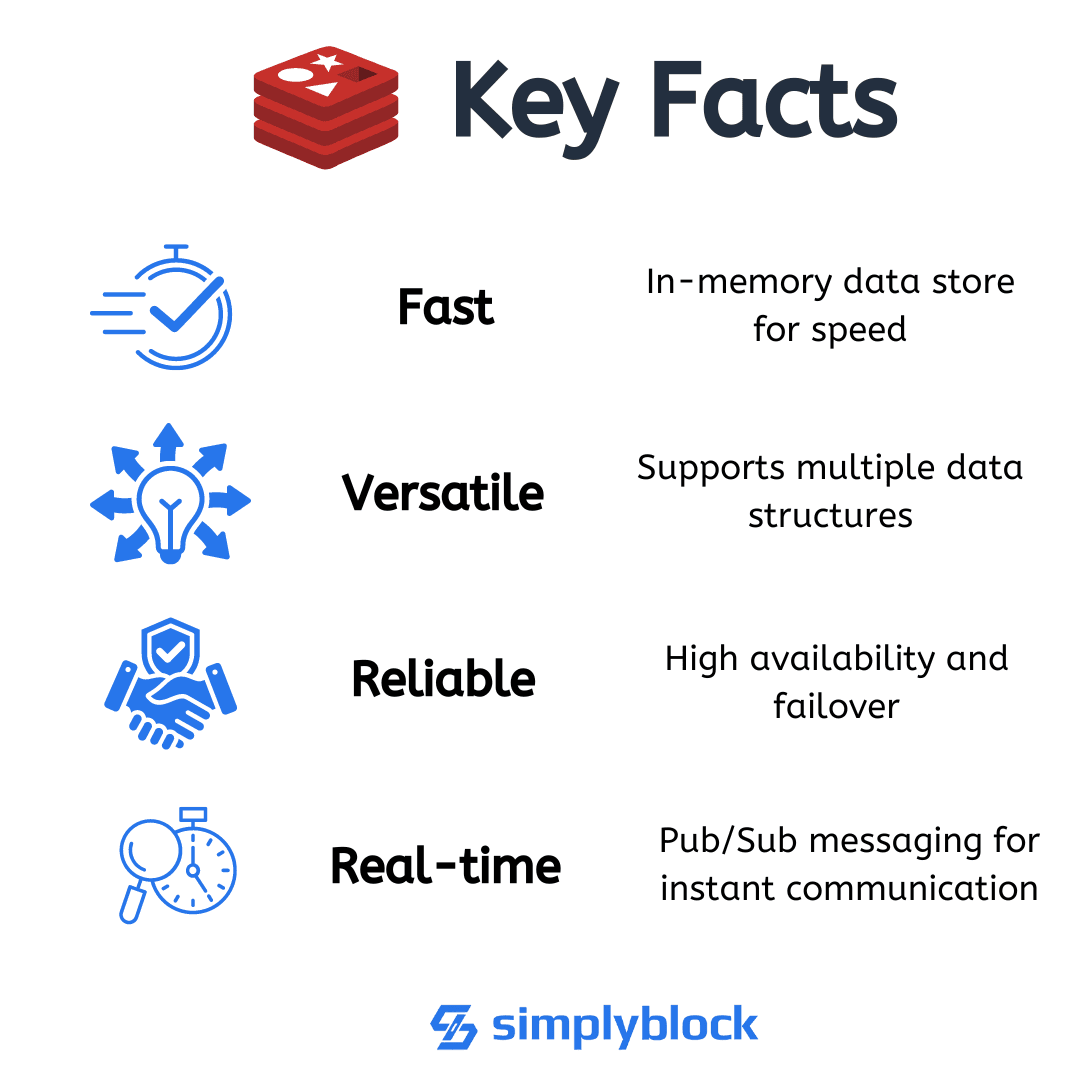Redis
Terms related to simplyblock
Redis (REmote DIctionary Server) is a high-performance, in-memory key-value database often used for caching, real-time analytics, messaging, and transient data storage. Written in C, Redis supports various data structures like strings, hashes, lists, sets, and sorted sets. Unlike traditional databases that persist data to disk first, Redis stores data primarily in memory, enabling sub-millisecond response times.
Redis is widely used in modern application stacks to offload read-heavy workloads, implement session stores, or provide real-time leaderboards, queues, and distributed locks.
Core Features of Redis
Redis offers features that go far beyond basic key-value storage:
- In-Memory Data Store: All data is kept in RAM for fast access.
- Rich Data Types: Supports strings, hashes, lists, sets, sorted sets, streams, bitmaps, and hyperloglogs.
- Persistence Options: Supports RDB snapshots and AOF (Append-Only File) logging.
- Replication: Master-replica model for read scalability and high availability.
- Pub/Sub Messaging: Built-in publish-subscribe support for message broadcasting.
- Lua Scripting: Atomic execution of custom logic on the server side.
- Cluster Mode: Horizontal scaling with automatic partitioning and failover.
- Stream Support: High-throughput message queues for event processing.
For Kubernetes-native or hybrid cloud deployments, using NVMe-class storage like simplyblock for persistence layers such as AOF or backup volumes ensures consistent performance even during I/O-intensive operations.
Redis Use Cases
Redis is integral to architectures that require fast, low-latency access to frequently changing or accessed data. Typical use cases include:
- Caching Layer: Reduces database load by caching query results, HTML fragments, or computed values.
- Session Storage: Stores user sessions in a scalable and stateless manner.
- Real-Time Leaderboards: Sorted sets enable ranking logic for games, sports, or finance.
- Job Queues: Lists and streams provide reliable queuing mechanisms for background processing.
- Rate Limiting: Supports token buckets and counters for throttling APIs or actions.
- Pub/Sub Systems: Efficiently distributes messages across services in real time.
- Machine Learning Feature Stores: Stores high-throughput feature vectors during training and inference.
For AI, edge, or microservices environments where IOPS and latency are critical, integrating Redis with simplyblock’s NVMe over TCP infrastructure ensures durability and speed.

Redis vs Other Key-Value and NoSQL Databases
Redis stands out for its in-memory architecture and command-level simplicity. Here’s how it compares to other NoSQL solutions:
| Feature | Redis | Memcached | Cassandra | MongoDB |
|---|---|---|---|---|
| Storage Type | In-memory + disk | In-memory only | On-disk (distributed) | On-disk (JSON docs) |
| Data Structures | Rich (sets, lists, etc.) | Strings only | Wide-column | Document-based |
| Persistence | Optional (RDB/AOF) | None | Built-in | Built-in |
| Replication | Master-replica | Manual | Peer-to-peer | Replica sets |
| Use Cases | Caching, queues, pub/sub | Caching | Analytics, logging | General purpose |
Redis is purpose-built for performance-critical, real-time operations, whereas others offer more persistence or schema-driven storage.
Redis Persistence and Storage Considerations
While Redis is an in-memory-first system, persistence is crucial for durability and recovery. Redis supports two modes:
- RDB (Redis Database Backup): Creates point-in-time snapshots at configured intervals.
- AOF (Append-Only File): Logs every write operation for real-time durability.
High-throughput applications require fast disk writes for AOF to avoid latency spikes. Deploying Redis with NVMe-backed block storage like simplyblock ensures:
- Low-latency IOPS for AOF logging
- Resilient backups without slowing in-memory operations
- Thin provisioning for optimal memory/disk ratio
- Advanced erasure coding for efficient durability
Redis in Kubernetes and Edge Environments
Redis is Kubernetes-friendly via Helm charts and Redis Operators, supporting StatefulSets and CSI volumes. Redis scales well in cloud-native and edge deployments when combined with:
- CSI-based persistent volumes from simplyblock for Kubernetes
- Multi-tenancy and QoS for managing Redis across tenants or workloads
- Instant volume snapshots for backup, cloning, or rollback
- Support for HA, failover, and external connectivity
This makes Redis not just a developer tool, but a scalable, resilient component in distributed systems.
External References
Questions and Answers
Redis is an in-memory data store known for sub-millisecond latency, making it ideal for caching, real-time analytics, session storage, and pub/sub messaging. Its support for complex data types and atomic operations makes it a go-to for high-performance applications.
Yes, Redis is widely deployed on Kubernetes using Helm charts or operators. For production use, pairing Redis with NVMe-powered Kubernetes storage ensures data persistence, rapid failover, and low-latency access across pods.
Although Redis is in-memory, persistence modes like RDB and AOF benefit from fast storage. Using NVMe over TCP provides low write latency, ensuring high performance and faster recovery for Redis workloads.
Redis offers TLS for encryption in transit but lacks native encryption at rest. To secure persistent data snapshots or append-only files, integrate encryption-at-rest through the storage layer for compliance and multi-tenant protection.
Redis supports logical separation via databases, but for strong isolation in multi-tenant setups, it’s best combined with software-defined storage that offers per-volume encryption and performance isolation between tenants.
